New Bio of Beatles Roadie Mal Evans Uncovers Last Known Photo of John Lennon and Paul McCartney Together (Exclusive)
- Oops!Something went wrong.Please try again later.
- Oops!Something went wrong.Please try again later.
- Oops!Something went wrong.Please try again later.
Drawn from the unpublished memoirs of the Fabs' confidant and constant shadow, the two-volume set is a holy grail for fans, offering an unparalleled look into the band
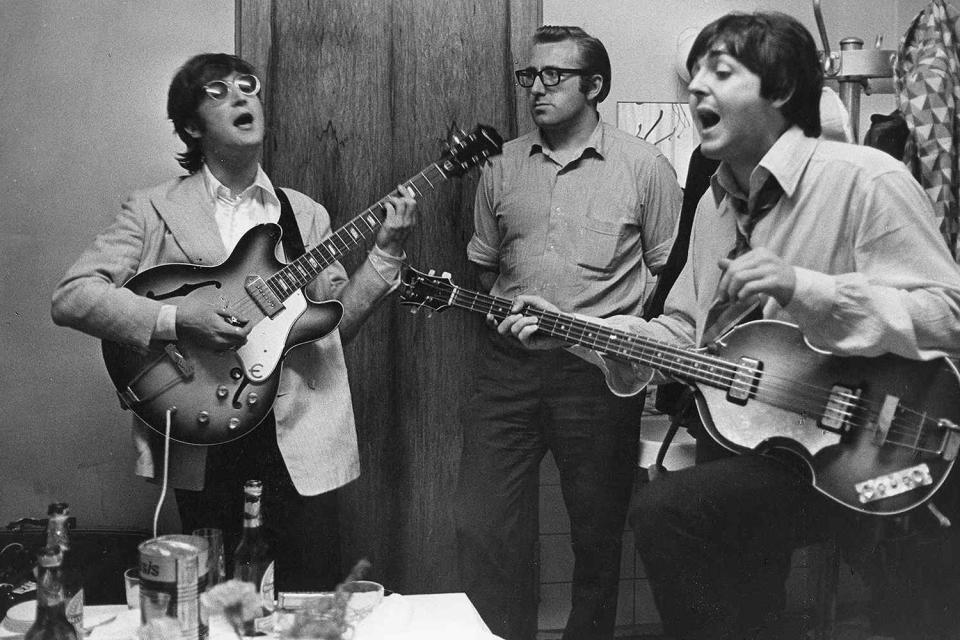
Robert Whitaker
John Lennon, Mal Evans and Paul McCartney backstage at Munich's Circus-Krone-Bau, 1966In addition to busting myths about the final days of the Fab Four and providing an intimate glimpse into one of the most beloved musical partnerships of the modern era, Peter Jackson’s 2021 docuseries Get Back introduced fair weather Beatles fans to Mal Evans. Whether having the time of his life taking an anvil solo on early rehearsals of “Maxwell’s Silver Hammer,” distracting the London bobbies trying to bust up the infamous rooftop gig, lugging guitars or delivering endless cups of tea, the nattily dressed, shaggy-haired gent became one of the breakout stars of the eight-hour epic, lightening tense moments with his good-natured grin and the mischievous twinkle behind his horned-rimmed glasses. His moment at center stage was long overdue, since he spent most of his life on the very edge of the Beatles’ white hot spotlight.
As their ever-present road manager, protector, fixer and trusted confidant, he’s one of the very few who can make a legitimate claim to Fifth Beatle status. (Though we’d probably place him at eighth…) Combing through photos of the Fabs throughout their career becomes like a game of rock ‘n’ roll Where’s Waldo. Whether on tour, in the studio, or even at play, you’ll inevitably find Evans in the background, his sturdy six-foot-three frame towering above everyone else. A gentle-giant, his ability to both lift Paul McCartney’s heavy bass amp and wordlessly persuade the most unruly of fans to step aside made him a welcome addition to the band’s one-person entourage back in 1963. From that moment on, Evans dedicated his life to their service. Even after their breakup in 1970, he remained one of the most loyal friends the band ever had — and their biggest fan.
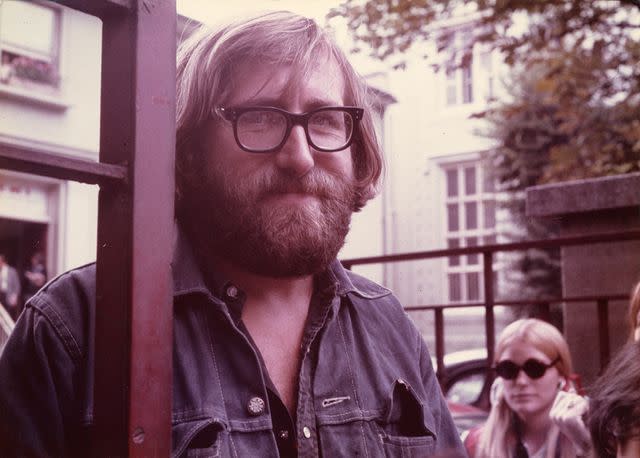
Malcolm Frederick Evans Archives
Mal Evans outside Abbey Road Studios in London, circa 1970A new biography by renowned Beatles scholar Dr. Kenneth Womack will delve deeper into the man who was the band’s shadow. Living the Beatles Legend: The Untold Story of Mal Evans, due out Nov. 14 on HarperCollins’ Dey Street Books imprint, draws extensively from the memoir of the same name Evans completed and planned to submit for publication. But following his tragic death in January 1976 at the age of 40, the project was shelved. In the decades since, the myth around the manuscript has continued to grow. Womack is also overseeing a second volume of the biography, slated to be published in 2024, showcasing elements of Evans’ vast personal archive. Dubbed “the Holy Grail” in Beatles circles, it contains diaries, artifacts, and never-before-seen photos — including what may be the very last image of McCartney and John Lennon ever taken together. (Which PEOPLE can exclusively premiere in the excerpt below!)
It’s a testament to the Beatles' love of “Big Mal” that the famously private foursome all granted him permission to pen his memoirs. Their individual approval letters are printed in Womack’s bio, and they’re all uniquely hilarious. “Sure, you can do your book,” writes McCartney, “as long as you tell them how lovely I am.” John Lennon’s note is characteristically more cheeky. “Good luck with the book. And heaven help us all! I’ve been dying to read your diary for the last thousand years! Make a buck, but don’t f--- it [up]...” Lennon had a right to be mildly concerned, as Evans was then — and, arguably, now — the most intimate band insider to share their complete story. (Harrison’s slight I Me Mine notwithstanding.) He quite literally saw it all because he was there, from Liverpool onward.
He was there for nearly every tour, setting up the stage and prepping the instruments at every stop. He was there for every recording session, standing by in the corner with cups of tea and ciggies while the foursome filled the room with their world-changing music. When the Beatles got high (supposedly) for the first time with Bob Dylan in 1964, it was Evans who ran and got a pad of paper for McCartney to scribble down the meaning of life he’d just worked out in his stoned mind. (Answer: “There are seven levels.”) When they paid a visit to Elvis Presley’s house in 1965, Evans was dispatched to the kitchen to break apart plastic spoons for homemade guitar pics. When the band scored their first US No. 1 with “I Want to Hold Your Hand” in January 1964, the newly minted international hitmakers immediately climbed on Evans for a piggyback ride. When angry mobs directed by Filipino dictator Ferdinand Marcos turned on the Beatles, Evans put his body on the line. A West Coast vacation with McCartney helped inspire the plot to their Magical Mystery Tour film, and evidence suggests he’s an uncredited co-writer on a handful of Beatles standards. What’s more, he also played on a few, including “Yellow Submarine,” “Being for the Benefit of Mr. Kite,""A Day in the Life,”and “Helter Skelter.” He helped make the Sgt. Pepper cover collage a reality, cameoed in the Beatles’ feature films A Hard Day’s Night and Help!, and developed numerous acts for the band’s new label, Apple—most notably, Badfinger.
Evans had a favorite phrase: “To serve is to rule.” There are many tales of his devotion. Living the Beatles Legend opens with a famous anecdote from one of his first nights working with the band, shuttling them up the 200-mile route from London to Liverpool in January 1963. Unfortunately, a pebble hit the windshield early in their journey, sending it splintering into shards of glass. Undeterred, Evans put his hat over his fist and punched out the remainder of the windshield and drove on, with nothing between him and the subzero temperatures of Britain’s coldest winter in 150 years. No job was too painful, and no task was beneath him. Womack quotes McCartney’s friend Barry Miles, who “once overheard John mutter ‘Socks, Mal!’ and an hour later Mal appeared in the studio with a dozen different pairs of brightly colored socks. Where Mal found them in the middle of the night is a mystery.”
Still another associate recalls a night where Evans spent a solid 20 minutes genially persuading a belligerent drunk to vacate the lobby of the Beatles’ recording studio. When later asked why he didn’t simply pick up the much smaller man and toss him out, Evans shook his head. “If I had done that, then the bloke would have gone back and told his mates, ‘What a bunch of bastards those guys are.’ Instead, he walked away, really happy, thinking what a nice bunch of people we are. What we do reflects on the band. It’s about the band.”
Living the Beatles Legend features Evans own insights on the group's final days and ultimate split — an experience that left him traumatized and struggling to find his own identity. Yet he remained close to all the former Fabs prior to his death, and even relocated to Los Angeles with Lennon in 1973. The ex-Beatle was in the midst of his infamous 18-month separation from wife Yoko Ono, forever known as “The Lost Weekend.” The estrangement inadvertently set the stage for a musical reunion with McCartney, who joined him in the studio on March 28, 1974 for their only known post-Beatles recording session. Unfortunately, the results were a drugged up shambles, but Evans couldn’t care less. His heroes were together again.
PEOPLE has an excerpt of Living the Beatles Legend detailing Evans’ debauched time with in LA recording Lennon's album Rock 'n' Roll, his memories of the final Lennon-McCartney recording session, and what may be the last photo of Lennon and McCartney together — captured by Evans’ camera.
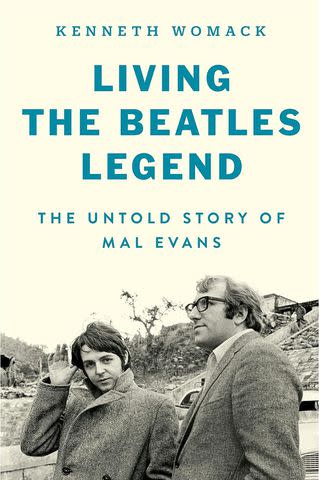
What John would later describe as his Lost Weekend—a nod to the 1945 Billy Wilder film noir classic of the same name—began in the summer months of 1973. Yoko had kicked John out of the Dakota, their fortress-like apartment building on Central Park West, after his drinking and public debauchery grew out of control. During the Lost Weekend, “I was just insane,” John admitted. “I’ve never drunk so much in my life, and I’ve been drinking since I was 15. But I really tried to drown myself in the bottle, and it took an awful lot. I don’t seem strong physically that much, but it just seems to take an amazing lot to put me down. And I was with the heaviest drinkers in the industry.” Those drinkers grew to include the likes of Ringo, Harry Nilsson, Keith Moon, Alice Cooper . . . and Mal.
As Mal soon discovered, working with John during this period would prove to be a chore—incomparable, in fact, to their touring years together, when the Beatles were often confined to the relative safety of a hotel suite. When he was in L.A., John could often be found at the Sunset Strip’s Rainbow Bar and Grill, which had emerged as his de facto headquarters during the Lost Weekend. With musicians like John, Harry, Ringo, Moonie, Alice Cooper, and Micky Dolenz adopting the Rainbow as their regular watering hole, they had taken to calling themselves the Hollywood Vampires, a nickname that evoked the night hours they spent guzzling hooch in the bar’s loft space.
On one of his most harrowing evenings in Los Angeles, Mal had accompanied John and [record producer] Phil Spector to the Rainbow. At one point, John walked Phil to his car, assuring Mal that he would return shortly. “About a half hour goes by, and I start worrying and go outside looking for John—no sign,” Mal later wrote. “I’d lost track of a Beatle for a day. What had happened, I found out the following evening, was that when he’d seen Phil off, a few hippie fans of his took him in tow, and John, who had just moved into a flat, couldn’t remember the address, nor his or my phone numbers. [John] eventually turn[ed] up, but not before I’d had a few irate words from Yoko, who phoned me from New York shouting, ‘I thought you were John’s bodyguard—why don’t you guard his body?’” At a loss for words, Mal admitted that “I never really thought of myself as a bodyguard to anybody, but I suppose over the years that had been part of the gig. Anyway, they were all grown up, with very strong minds of their own as to what they wanted to do, and I certainly didn’t expect them to hold themselves accountable to me.”
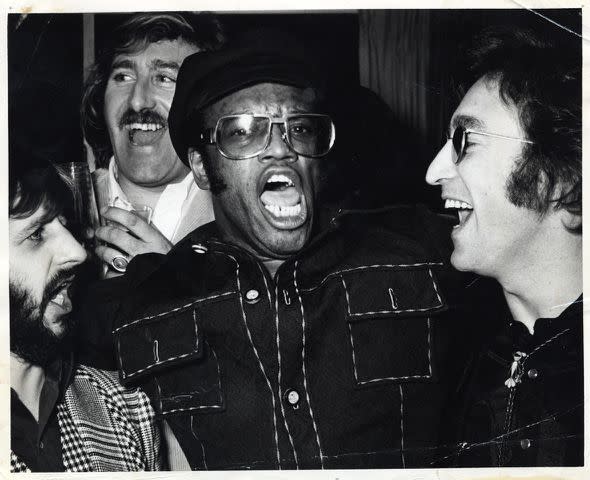
Malcolm Frederick Evans Archives
Ringo Starr, Mal Evans, and John Lennon with Bobby Womack, 1973Spector would play an outsized role in the chaos of the Lost Weekend when he signed on to produce Lennon's covers album of '50s rock standards, released in 1975 under the evocative (if not creative) titled Rock 'n' Roll. Spector's notorious temper was exacerbated by his excessive intake of drugs and booze, and Evans found himself in the unenviably role of having to protect Lennon from his own producer.
That December, as work on Back to Mono [later retitled Rock 'n' Roll] proceeded, John and Phil shifted their project to the Record Plant West. The change of recording studios had nothing to do with the amenity-rich facilities and everything to do with John’s and Phil’s antics having gotten them evicted from A&M [Studios]. At one point, Harry Nilsson and Keith Moon, in a drunken stupor, had urinated onto the studio’s recording console, leaving the electronics in an ungodly mess. In a letter to Phil entitled “A Matter of Pee,” John wrote that “I can’t be expected to mind adult rock stars… I’m about to piss off to Record Plant because of this crap!"
Mal was delighted by the change of venue, but within a remarkably short period—only a few sessions, really—John’s Lost Weekend would leave its mark on the Third Street facility. As for Phil, nobody in the business had any illusions about the producer’s condition. “He was bats— crazy,” said [Evans' girlfriend] Fran, who pointed out that the industry tolerated Spector only because he was a legendary hitmaker of yore.
Things began innocently enough after John and Phil completed their Dec. 11 session at the Record Plant West, where they took a pass at Chuck Berry’s “You Can’t Catch Me.” As Mal looked on, the two men, drunk to the gills, were horsing around. In a nod to the early days of Beatlemania, John decided to hop onto Mal’s back for a piggyback ride. Unfortunately, Phil opted to get in on the act, too. Mal’s physical dexterity in late 1973 was a far cry from that of the early 1960s, and he had difficulty sustaining the weight of two men atop his aching back. As always, Mal observed, “Phil goes a little too far,” and in the ensuing ruckus, “he karate-chopped me on the nose, my spectacles went flying, and I got tears in my eyes I can tell you. I turned around with a real temper and told Phil, ‘Don’t ever lay another finger on me, man.’”
And that’s when Phil, “maybe to reestablish himself in his own eyes,” Mal thought, pulled out a handgun. To the roadie’s surprise, the producer “fired it off under our noses, deafening us both, the bullet ricocheting around the room and landing between my feet.”
John was understandably incensed, exclaiming to Phil, “If you’re gonna kill me, kill me, but don’t take away my hearing—it’s me living!”
Until that moment, Mal and John had believed that Spector’s handgun was a toy. At one point earlier in the evening, Phil had cocked the trigger and aimed the weapon at John’s head. As a result of the incident, “John’s fear of guns generally was doubled.” For his part, Mal vowed to stay clear of Phil. He would attend the recording sessions in deference to John, but that was it.
[By the spring of 1974], the Back to Mono production had gone on hiatus after Spector’s reckless behavior finally caught up with him in the form of a harrowing car accident. Barely escaping with his life after being catapulted through the windshield of his Rolls-Royce, he had required some seven hundred stitches. As for Harry Nilsson, his latest record, A Little Touch of Schmilsson in the Night, had hit the charts with a thud, and he was eager to recapture the glory days of his “Without You” era. As his drinking buddy and bosom companion, John offered to serve as producer on the singer’s next album. Thanks to Spector’s penchant for driving while intoxicated, John had plenty of free time on his hands.
For Harry’s album—which went under the working title Strange Pussies [later renamed Pussy Cats]—John intended to pull out all the stops for his friend, and this meant procuring the services of Mal to stage-manage the production. After the drunken debauchery associated with Back to Mono, there was little doubt that Strange Pussies would be no easy feat. Knowing Harry’s hard-drinking proclivities, John reasoned that the best way to proceed would be to ensure that the album’s motley group of participants lived under the same roof for the duration of the project. Their salvation arrived in the form of an opulent seaside estate in Santa Monica.
On the advice of Ringo’s personal lawyer, Bruce Grakal, John and [girlfriend] May Pang toured the Spanish-style mansion on Palisades Beach Road, easily the most storied address among California’s Gold Coast abodes. Constructed in 1926, the home had been the brainchild of legendary Hollywood mogul Louis B. Mayer. The estate had earned a notorious reputation in later years, after it was purchased by actor Peter Lawford and his wife, Patricia (née Kennedy). As John already knew, in the early 1960s, 625 Palisades Beach Road was the site of President John F. Kennedy and Marilyn Monroe’s love nest.
When it came time to move into the rented house, John and May took the master bedroom for themselves, with Lennon quipping “so this is where they did it,” referring to Kennedy and Monroe’s seaside assignations.The other bedrooms at the estate were allotted to Harry, Keith Moon, and Klaus Voormann, with the estate’s library—complete with President Kennedy’s portrait on the wall—converted into a bedroom for Ringo, who was in town to escape his failing marriage. For the purposes of recording Strange Pussies, RCA Records had blocked off studio time for John and Harry at the Record Plant.
For those associated with Strange Pussies, the project was doomed from the start, with John and Harry earning international headlines after being kicked out of the Troubadour [nightclub] for disorderly behavior after heckling the Smothers Brothers earlier that same month. For Mal especially, working on Harry’s album was nothing short of a disaster. For one thing, most of the players subsisted in a state of perpetual drunkenness worsened only by the lines of cocaine being doled out. It didn’t help that the other principal musicians—saxophonist Bobby Keys and guitarists Jesse Ed Davis and Danny Kortchmar—were world-beating partiers in their own right. Along with May, a lifelong teetotaler, Mal struggled to keep the troops in order and working toward the common goal of righting Harry's career. When the sessions devolved into chaos, which they invariably did, Mal would throw up his hands in defeat and join the revelry.
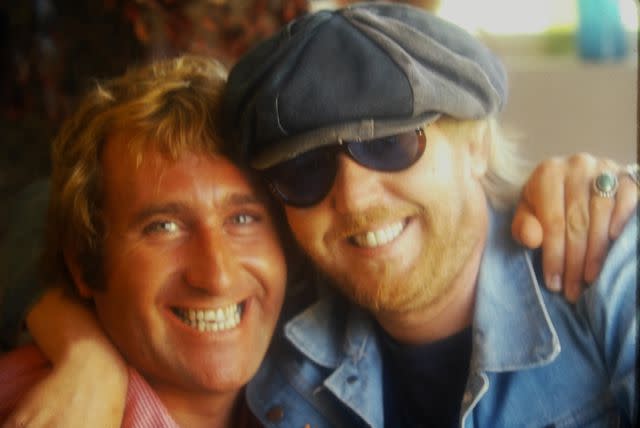
Malcolm Frederick Evans Archives
Mal Evans with Harry Nilsson, mid '70s.For Mal, the album achieved its zenith on March 28. In many ways, that evening alone should have given Strange Pussies the kick in the ass it sorely needed. But the players simply weren’t up to it. That night, none other than Paul and Linda had strolled into the Record Plant. Ever the sentimentalist, Mal was overcome by emotion at the sight of John and Paul together for the first time since [George Harrison's wife] Pattie’s March 1970 birthday celebration at Friar Park. Unfortunately, the music they made that night was a different matter altogether. In truth, Mal couldn’t have asked for a more talented assemblage of musicians under a single roof. The great Lennon and McCartney were on hand, of course, along with Nilsson, Davis, and Keys. Better yet, they had been joined that evening by Stevie Wonder, who chipped in on keyboards. With nary a drummer in sight, Paul strode behind Ringo’s empty drum kit, joining John and a series of ragged lead vocals on such chestnuts as “Lucille” and “Stand by Me.” For their part, Mal and May made half-hearted efforts at percussion. After several sloppy attempts at finding a groove, the musicians mercifully called it quits. What might have been an unexpected Lennon-McCartney triumph had ended in an amateurish, desultory jam.
For Mal, the sunny afternoon of March 29 would bring pure magic in contrast with the previous evening’s lackluster proceedings. The McCartney clan showed up [at the Santa Monica beach house] out of the blue, this time with daughters Heather, Mary, and Stella in tow, and Mal was thrilled at the prospect of seeing John and Paul together again—twice in the span of two days, no less. And he was by no means disappointed, observing the two old friends reclining on the patio together and, later, walking along the beach, with May, Linda, and the McCartney brood trailing along behind them. “Nice to see him and John together,” Mal scribbled in his diary later that month.
At one point that afternoon, Evans reached for his camera and snapped a photo of the two old friends lounging at the beach house — flanked by their partners, Linda and May Pang, and Harry Nilsson. May would also take some Polaroids of the meeting at some point this day, but there's a very real possibility that Evans' picture is the last photo ever taken of the 20th Century's greatest songwriting duo. (It will be included in the upcoming collection of Evans' diaries and archives, slated for publication in 2024.)
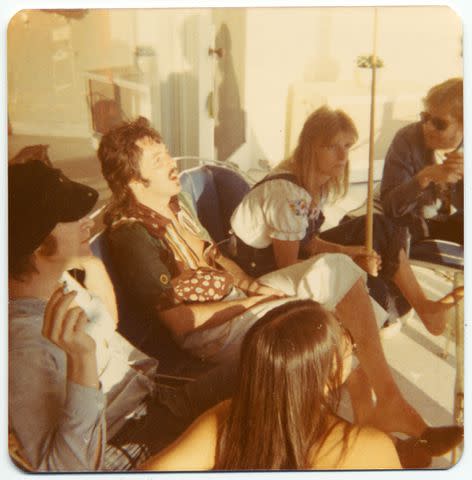
Malcolm Frederick Evans Archives
Newly unearthed photo taken of John Lennon and Paul McCartney together on March 29, 1973A week after taking the historic photo, Evans returned to the Santa Monica beach house on April 6, 1974, to have one of the most difficult conversations of his life. After dedicating himself body and soul to the Beatles for more than a decade, he was about to tender his resignation. It was the only way to forge his own path as a budding producer, songwriter, and talent scout. Thankfully, three of the Fab Four were in residence at the beach house that day, so he could say his farewells in person.
Girding his courage, Mal sought out John first. To his relief, the Beatle was sitting alone by a table in the living room. “I told him that I felt it was time for me to become my own person and do my own thing,” Mal later recalled. He had to admit that “doing his own thing” wasn’t entirely clear in that moment. “For too long, I had been resting on my laurels,” he told John, “not doing anything constructive for them nor myself except on a personal level, and I would never stop doing that, no matter what.” And with that, Mal braced himself for John’s reaction.
Without missing a beat, John piped up, saying, “It’s about time, Mal. I was wondering when you would come to it. You’re certainly capable of standing on your own two feet now, and I wish you all the luck in the world. If you ever need me, I’ll be there,” he continued, “and I know your songwriting will develop into a career for you.”
As it happened, Ringo’s reaction was more difficult to gauge. In Mal’s memory, the two old friends “sat together at the bottom of the garden, just lying back in the sunshine.” When Mal informed the drummer of his decision, Ringo went quiet. By contrast, Paul proved to be eminently more receptive, taking Mal in a warm embrace and saying, “Good on you, lad. I know you’ll be very successful—you deserve to be.”
That Sunday evening, [Mal] joined John, May, and a bevy of other friends for a seafood dinner at the Crab Shell, a bistro on Venice Beach. Harry was there, of course. He confided in Mal that Ringo had stayed up with him drinking well into the night and weeping as he took in the full measure of Mal’s decision. “Now that Mal’s left,” Ringo had cried to Harry, “the Beatles are really over.”
Excerpted from LIVING THE BEATLES LEGEND: The Untold Story of Mal Evans by Kenneth Womack. Copyright © 2023 by Kenneth Womack. Reprinted by permission of Dey Street, an imprint of HarperCollins Publishers.
For more People news, make sure to sign up for our newsletter!
Read the original article on People.

